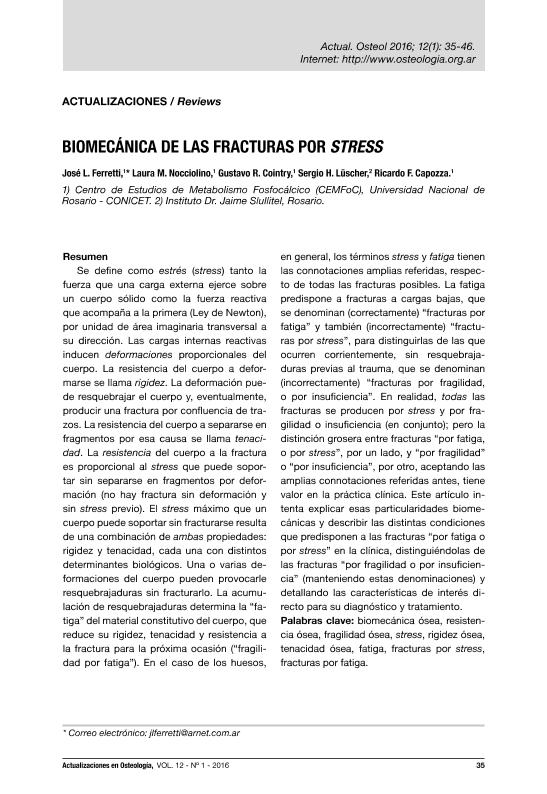Mostrar el registro sencillo del ítem
dc.contributor.author
Ferretti, Jose Luis

dc.contributor.author
Nocciolino, Laura Marcela

dc.contributor.author
Cointry, Gustavo Roberto

dc.contributor.author
Luscher, Sergio Hugo

dc.contributor.author
Capozza, Ricardo Francisco

dc.date.available
2022-12-02T16:56:26Z
dc.date.issued
2016-05
dc.identifier.citation
Ferretti, Jose Luis; Nocciolino, Laura Marcela; Cointry, Gustavo Roberto; Luscher, Sergio Hugo; Capozza, Ricardo Francisco; Biomecánica de las fracturas por stress; Asociación Argentina de Osteología y Metabolismo Mineral; Actualizaciones en Osteologia; 12; 1; 5-2016; 35-46
dc.identifier.issn
1669-8975
dc.identifier.uri
http://hdl.handle.net/11336/180030
dc.description.abstract
Se define como estrés (stress) tanto la fuerza que una carga externa ejerce sobre un cuerpo sólido como la fuerza reactiva que acompaña a la primera (Ley de Newton), por unidad de área imaginaria transversal a su dirección. Las cargas internas reactivas inducen deformaciones proporcionales del cuerpo. La resistencia del cuerpo a deformarse se llama rigidez. La deformación puede resquebrajar el cuerpo y, eventualmente, producir una fractura por confluencia de trazos. La resistencia del cuerpo a separarse en fragmentos por esa causa se llama tenacidad. La resistencia del cuerpo a la fractura es proporcional al stress que puede soportar sin separarse en fragmentos por deformación (no hay fractura sin deformación y sin stress previo). El stress máximo que un cuerpo puede soportar sin fracturarse resulta de una combinación de ambas propiedades: rigidez y tenacidad, cada una con distintos determinantes biológicos. Una o varias deformaciones del cuerpo pueden provocarle resquebrajaduras sin fracturarlo. La acumulación de resquebrajaduras determina la “fatiga” del material constitutivo del cuerpo, que reduce su rigidez, tenacidad y resistencia a la fractura para la próxima ocasión (“fragilidad por fatiga”). En el caso de los huesos, en general, los términos stress y fatiga tienen las connotaciones amplias referidas, respecto de todas las fracturas posibles. La fatiga predispone a fracturas a cargas bajas, que se denominan (correctamente) “fracturas por fatiga” y también (incorrectamente) “fracturas por stress”, para distinguirlas de las que ocurren corrientemente, sin resquebrajaduras previas al trauma, que se denominan (incorrectamente) “fracturas por fragilidad, o por insuficiencia”. En realidad, todas las fracturas se producen por stress y por fragilidad o insuficiencia (en conjunto); pero la distinción grosera entre fracturas “por fatiga, o por stress”, por un lado, y “por fragilidad” o “por insuficiencia”, por otro, aceptando las amplias connotaciones referidas antes, tiene valor en la práctica clínica. Este artículo intenta explicar esas particularidades biomecánicas y describir las distintas condiciones que predisponen a las fracturas “por fatiga o por stress” en la clínica, distinguiéndolas de las fracturas “por fragilidad o por insuficiencia” (manteniendo estas denominaciones) y detallando las características de interés directo para su diagnóstico y tratamiento.
dc.description.abstract
The term “stress” expresses the force exerted by an external load on a solid body and the accompanying, opposed force (Newton’s Law), expressed per unit of an imaginary area perpendicular to the loading direction. The internal loads generated this way deform (strain) proportionally the body’s structure. The resistance of the body to strain expresses its stiffness. Critical strain magnitudes may induce micro-fractures (microdamage), the confluence of which may fracture the body. The body’s resistance to separation into fragments determines its toughness. Hence, the body’s resistance to fracture is proportional to the stress the body can support (or give back) while it is not fractured by the loadinduced strain (no stress, no strain -> no fracture). Therefore, the maximal stress the body can stand prior to fracture is determined by a combination of both, its stiffness and its toughness; and each of those properties is differently determined biologically. One or more deformations of the body may induce some microdamage but not a fracture. Microdamage accumulation determines the fatigue of the material constitutive of the body and reduces body’s toughness, leading to a “fatigue-induced fragility”. In case of bones, in general, both stress and fatigue have the referred, wide connotations, regarding any kind of fractures. In particular, bone fatigue predisposes to low-stress fractures, which are named (correctly) “fatigue fractures” and also misnamed “stress fractures”, to distinguish them from the current fractures that occur without any excess of microdamage, that are named (wrongly) “fragility” or “insufficiency” fractures. In fact, all fractures result from all stress and fragility or insufficiency as a whole; however, the gross distinction between “fatigue or stress fractures”, on one side, and “fragility or insufficiency fractures”, on the other, accepting the wide connotations of the corresponding terminology, is relevant to clinical practice. This article aims to explain the above biomechanical features and describe the different instances that predispose to “fatigue or stress fractures” in clinical practice, as a different entity from “insufficiency or fragility fractures” (maintaining this nomenclature), and describe their relevant features to their diagnosis and therapy.
dc.format
application/pdf
dc.language.iso
spa
dc.publisher
Asociación Argentina de Osteología y Metabolismo Mineral
dc.rights
info:eu-repo/semantics/openAccess
dc.rights.uri
https://creativecommons.org/licenses/by-nc-sa/2.5/ar/
dc.subject
BIOMECANICA OSEA
dc.subject
RESISTENCIA OSEA
dc.subject
FRAGILIDAD OSEA
dc.subject
STRESS
dc.subject.classification
Reumatología

dc.subject.classification
Medicina Clínica

dc.subject.classification
CIENCIAS MÉDICAS Y DE LA SALUD

dc.title
Biomecánica de las fracturas por stress
dc.title
Biomechanical features of stress fractures
dc.type
info:eu-repo/semantics/article
dc.type
info:ar-repo/semantics/artículo
dc.type
info:eu-repo/semantics/publishedVersion
dc.date.updated
2022-12-02T14:59:05Z
dc.journal.volume
12
dc.journal.number
1
dc.journal.pagination
35-46
dc.journal.pais
Argentina

dc.journal.ciudad
Rosario
dc.description.fil
Fil: Ferretti, Jose Luis. Consejo Nacional de Investigaciones Científicas y Técnicas. Centro Científico Tecnológico Conicet - Rosario; Argentina. Universidad Nacional de Rosario. Facultad de Ciencias Médicas. Centro de Estudios de Metabolismo Fosfocálcico; Argentina
dc.description.fil
Fil: Nocciolino, Laura Marcela. Consejo Nacional de Investigaciones Científicas y Técnicas. Centro Científico Tecnológico Conicet - Rosario; Argentina. Universidad Nacional de Rosario. Facultad de Ciencias Médicas. Centro de Estudios de Metabolismo Fosfocálcico; Argentina
dc.description.fil
Fil: Cointry, Gustavo Roberto. Consejo Nacional de Investigaciones Científicas y Técnicas. Centro Científico Tecnológico Conicet - Rosario; Argentina. Universidad Nacional de Rosario. Facultad de Ciencias Médicas. Centro de Estudios de Metabolismo Fosfocálcico; Argentina
dc.description.fil
Fil: Luscher, Sergio Hugo. Universidad Nacional de Rosario. Facultad de Ciencias Médicas. Centro de Estudios de Metabolismo Fosfocálcico; Argentina. Instituto Dr. Jaime Slullitel; Argentina
dc.description.fil
Fil: Capozza, Ricardo Francisco. Consejo Nacional de Investigaciones Científicas y Técnicas. Centro Científico Tecnológico Conicet - Rosario; Argentina. Universidad Nacional de Rosario. Facultad de Ciencias Médicas. Centro de Estudios de Metabolismo Fosfocálcico; Argentina
dc.journal.title
Actualizaciones en Osteologia
dc.relation.alternativeid
info:eu-repo/semantics/altIdentifier/url/https://osteologia.org.ar/articulo/2952/biomec-nica-de-las-fracturas-por-stress
Archivos asociados
